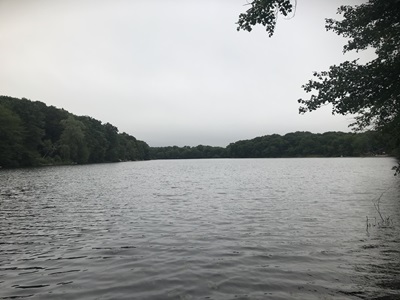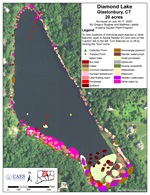Diamond Lake, Glastonbury - 2020
2020 Aquatic Plant Survey of Diamond Lake
Diamond Lake is a privately owned 20-acre body of water located south of Route 94 in the eastern section of Glastonbury. It is primarily spring fed and has a spillway on the southeast shore that allows for a six-inch drawdown. The maximum depth of the lake is about 12 feet and residents report “good” fishing. Lakefront development is sparse to moderate and most homes have left trees and natural vegetation along the lake. A large development north of the lake is underway but the road drains from it are not designed to flow to the lake. Local road drains do flow to the lake, but residents do not report seeing the lake turn brown from siltation during flood events. Agricultural impacts on the lake are minimal.
The 2020 survey was the second survey performed on Diamond Lake by CAES IAPP. The first survey was done in 2006. No invasive species were found in either survey. Plant diversity increased. In 2006, only nine aquatic plant species were found. The 2020 survey found 16 aquatic plant species.
In 2020, aquatic plants were present along much of the shoreline. The most common plant species were the floating-leaved species little floating heart (Nymphoides cordata), white water lily (Nymphaea odorata), and watershield (Brasenia schreberi). The southern end of the lake had the greatest abundance of plants with large amounts of small pondweed (Potamogeton pusillus), quillwort (Isoetes species), western waterweed (Elodea nuttallii), and slender waternymph (Najas gracillima).
Water clarity (transparency) decreased slightly from 2.5 m in 2006 to 2.0 m in 2020. Given that only two observations are being compared, inferring a trend is unwise. CAES research has found water clarities in Connecticut lakes range from 0.3 -10 m with an average of 2.3 m.
We analyzed Diamond lake’s water for key parameters in both survey years. Because the lake is quite shallow little it showed no surface to bottom summer stratification. Temperature profiles were similar in both years ranging from 27 °C at the surface to 23 °C at the bottom. Dissolved oxygen (DO) profiles were also similar in both years with high levels of 7 – 8 mg/L common at all depths except near the bottom in 2006 when a low level of 2.9 mg/L was recorded.
Diamond Lake had similar pH values in 2006 and 2020 with surface values of 6.3 and 6.6 and bottom values of 6.6 and 6.4. Alkalinity was slightly higher in 2020 at both the surface and the bottom increasing from 6.0 mg/L and 5.3 mg/L in 2006 to 12.0 mg/L and 9.8 mg/L, respectively. Conductivity showed the greatest change increasing from 67 µs/cm at the surface and 68 µs/cm at the bottom in 2006, to 163 µs/cm at the surface and 166 µs/cm at the bottom in 2020. Road salts could be a cause.
A key parameter used to categorize a lake’s trophic state is the concentration of total phosphorus (P) in the water column. High levels of P can cause problematic algal blooms while rooted macrophytes are less affected as they obtain most nutrients from the substrate. Lakes with P levels from 0 - 10 µg/L are considered nutrient-poor or oligotrophic. When P concentrations reach 15 - 25 µg/L, lakes are classified as moderately fertile or mesotrophic and when P reaches 30 - 50 µg/L they are considered fertile or eutrophic. Lakes with P concentrations over 50 µg/L are categorized as extremely fertile or hypereutrophic. Total phosphorus concentration in Diamond Lake change little between 2006 and 2020 with 11 µg/L and 12 µg/L, respectively. No differences occurred between the surface and bottom water.
Total nitrogen (TN) was recorded for the first time in 2020 with a finding of 421 ppb at the surface and 387 ppb at the bottom. Although nitrogen is likely less limiting than P to the growth of aquatic plants and algae, it may play a role in a lake’s productivity. CAES research has found TN in Connecticut lakes ranged from 193 - 1830 µg/L and averaged 554 µg/L.
| Species recorded in our 2020 survey of Diamond Lake. Scientific Names |
|||
| Bur-Reed | Little floating heart | Slender naiad | Watershield |
| Cattail | Pondweed | Small pondweed | Waterwort |
| Common bladderwort | Quillwort | Spikerush | Western waterweed |
| Humped bladderwort | Sevenangle pipewort | Swamp loosestrife | White water lily |
Other Diamond Lake Surveys: 2006



